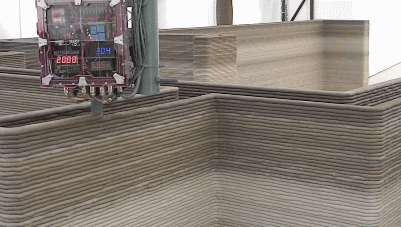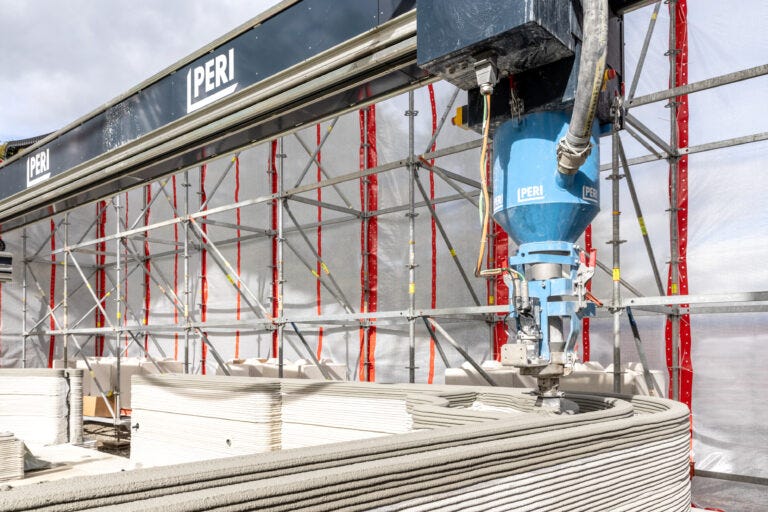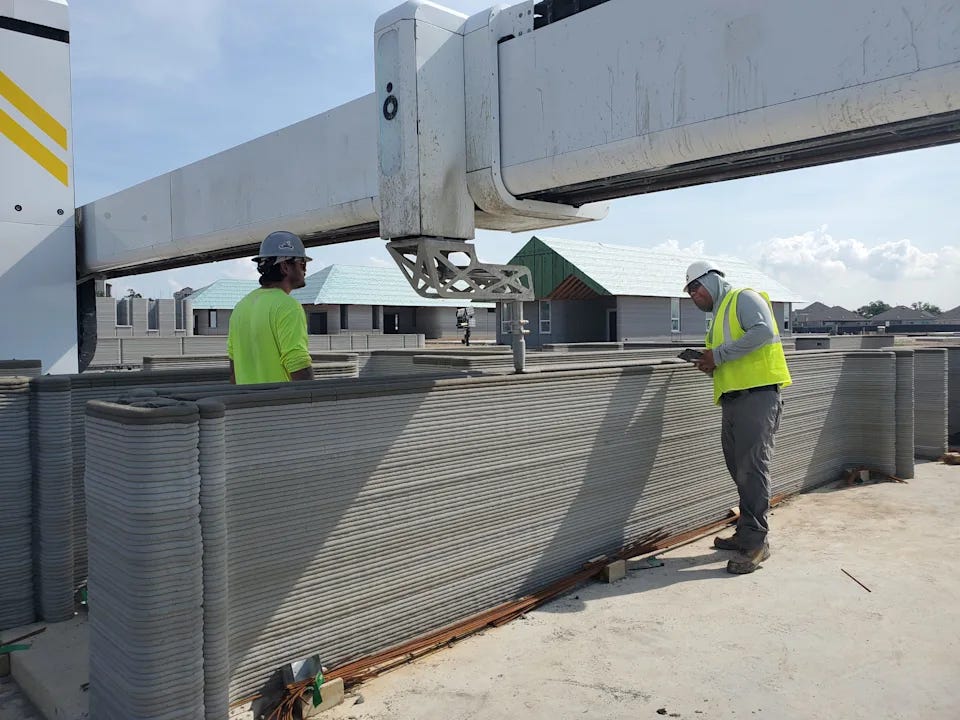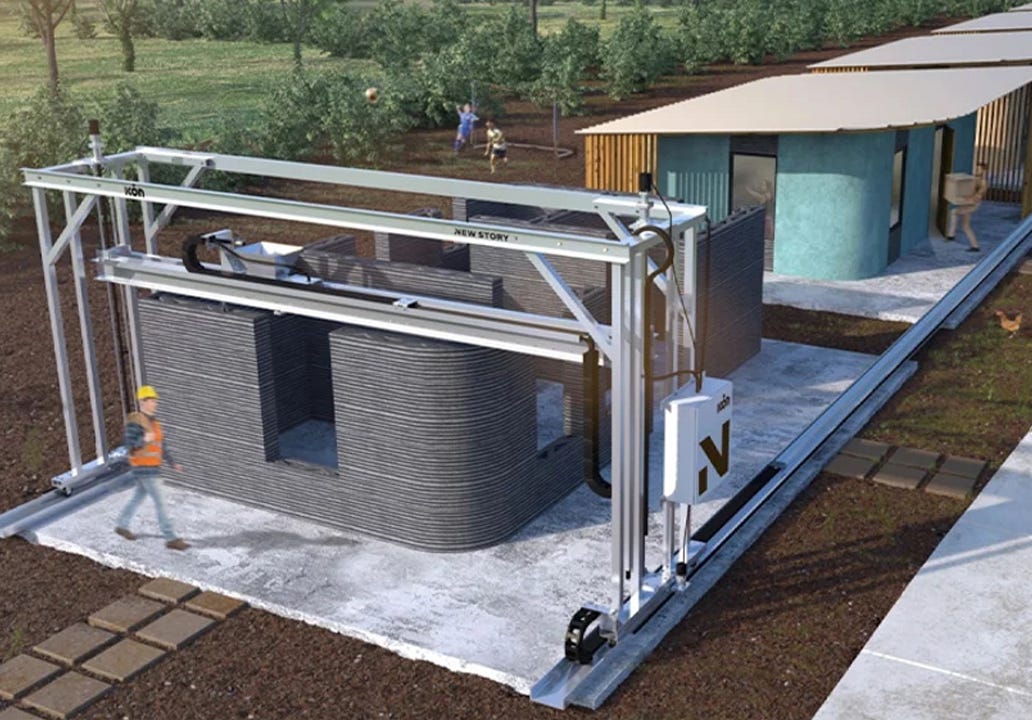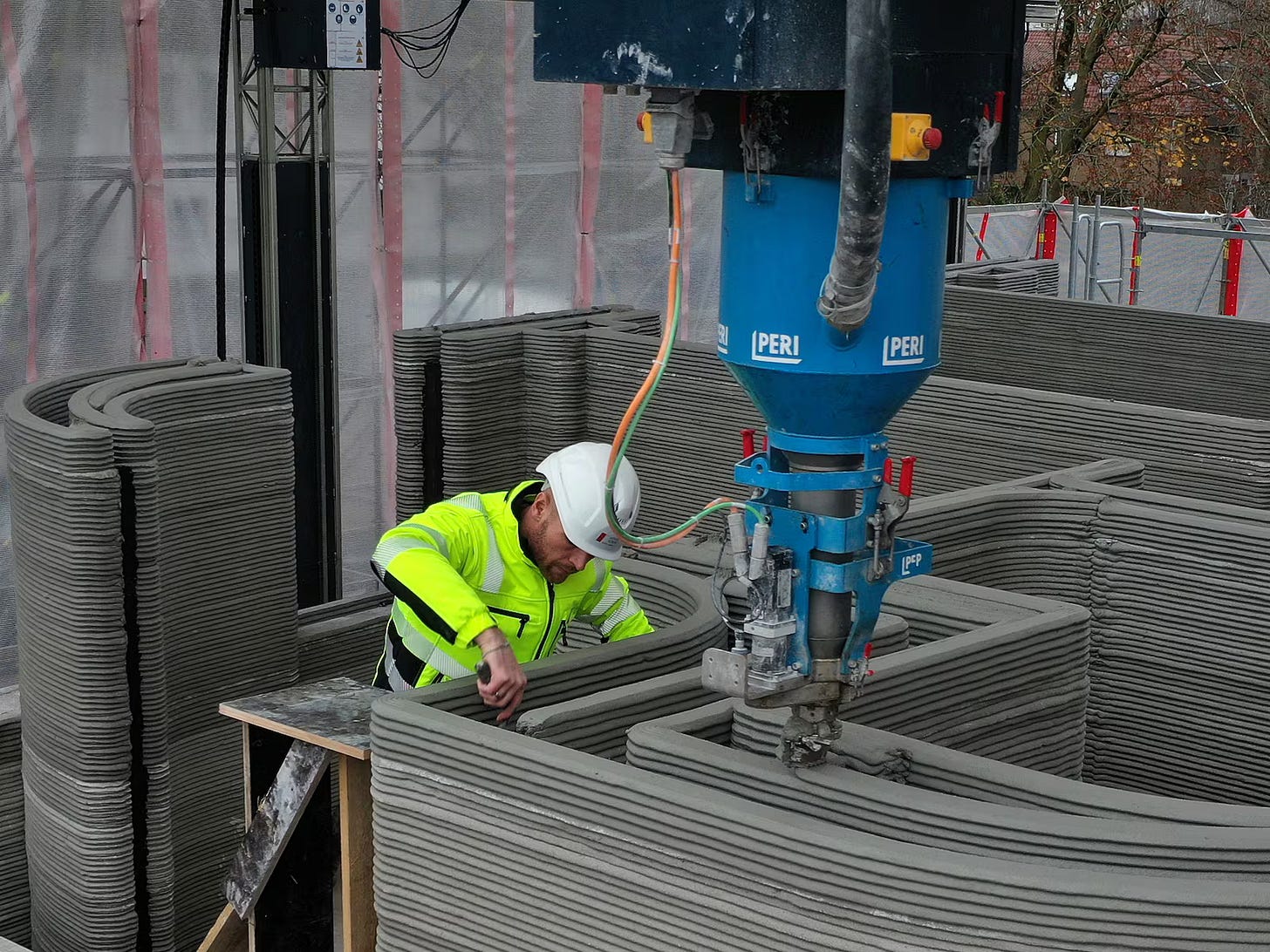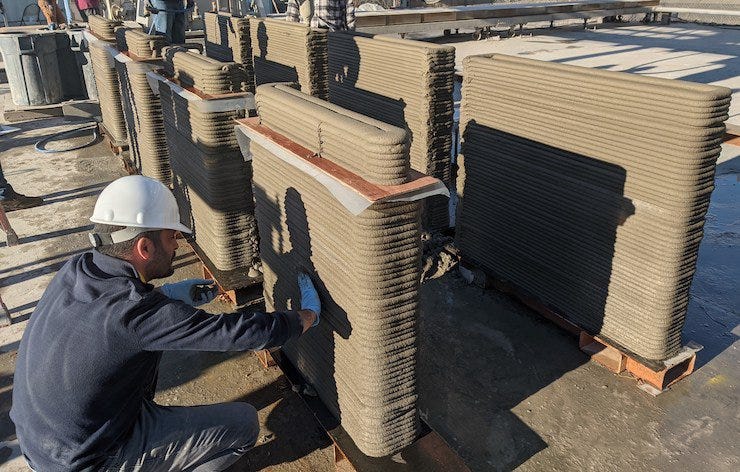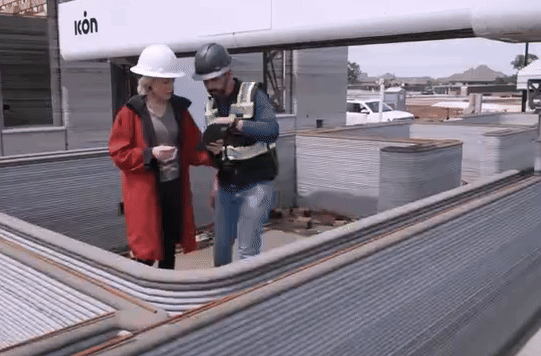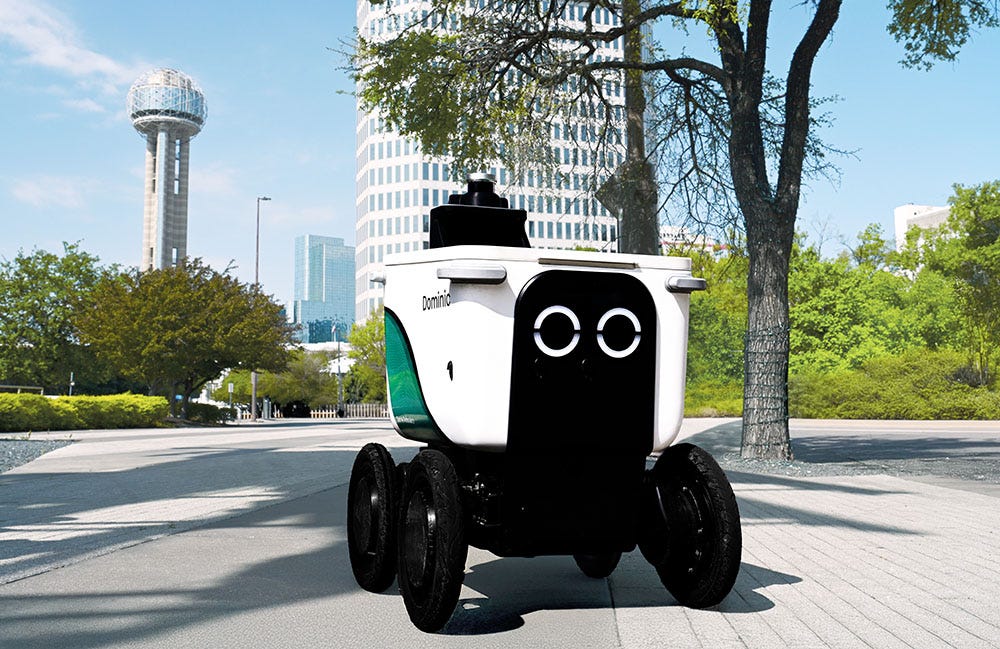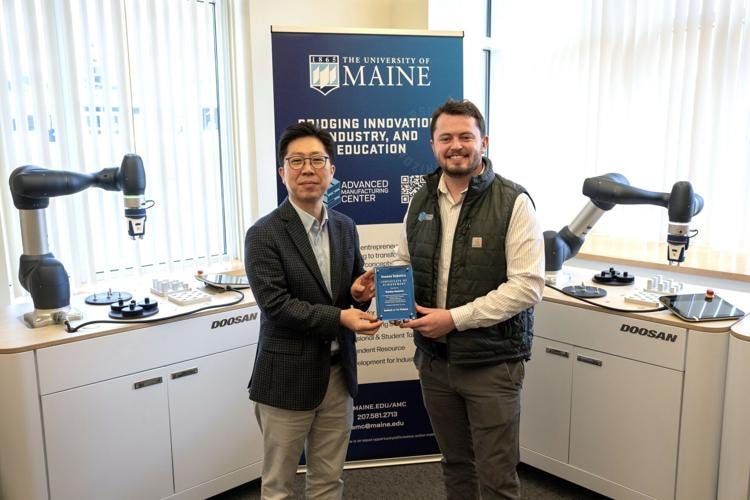Robots Are Printing Buildings. The Safety Rulebook Has to Catch Up.
As gantries and robotic nozzles move from warehouses to worksites, a new layer of application-specific safety standards is overdue.
“We can only see a short distance ahead, but we can see plenty there that needs to be done.” — Alan Turing
At dawn in Georgetown, Texas, a concrete nozzle swings into motion, gliding across a gantry crane as if it were drawing lines on a page. But instead of ink, it extrudes wet cement, layer by layer, into the walls of what developers are calling the world’s largest 3D-printed neighborhood. Thousands of miles away, in Heidelberg, Germany, a massive “server hotel” rises from the ground, promoted as Europe’s biggest single printed structure. And in Austin, a cluster of new homes is being printed and sold through the city’s affordable housing program, a glimpse of what the future of mass housing might look like.
What was once a futuristic promise—printing buildings instead of pouring them—is fast becoming a reality. Construction sites are no longer defined only by hard hats and rebar, but by robotic arms fitted with nozzles, mobile mixing units guided by software, and machines that never tire as they trace the contours of entire buildings. Together, these projects point to a tipping point: additive construction is no longer just a pilot experiment, but a practice beginning to scale.
Robot Standards Written for Factory Floors, Not Construction Sites
The safety standards guiding the robots behind this boom were written for a different world. The global baseline for industrial robot safety—ISO 10218, with the U.S. adoption in ANSI/RIA R15.06—defines the safe design of robots and the integration of robot systems. It is foundational, and U.S. OSHA explicitly points to R15.06 (which adopts ISO 10218-1/-2) as the national consensus benchmark; collaborative operations are further addressed in ISO/TS 15066 (adopted in the U.S. as TR 606). A revised ISO 10218 arrived this year to reflect newer capabilities so that we can expect changes to ANSI/RIA R15.06 as well.
Today, there is a lot of additive construction still taking place in controlled factory-like settings, where robotic arms or gantry systems print structural components that can be trucked to the job site and assembled like giant Lego blocks. That model—indoors, cordoned off, and surrounded by trained operators—fits neatly within the assumptions baked into today’s robot safety standards: fixed cells, predictable workflows, and well-defined perimeters.
But the long-term vision for the industry is far more ambitious: printers deployed directly on the job site, laying down walls, facades, and even entire buildings in real time. In that scenario, the boundaries between robot and human space blur. Heavy equipment shares ground with moving crews, wet materials, and shifting environmental conditions. Rain, wind, and heat become variables that standards writers never had to consider when drafting rules for factory floors. And yet that is precisely where the industry is heading (if not already there) toward open-air, on-demand printing, where the robots don’t just make pieces of buildings, but the buildings themselves.
Focus on Printed Products, Not Printing Processes
Meanwhile, building officials have been busy standardizing the printed products rather than the printing process. In 2022, the International Code Council Evaluation Service (ICC-ES) introduced Acceptance Criteria AC509 to define how 3D-printed concrete walls should be evaluated for structural performance and code compliance. ICON became one of the first companies to secure an ICC-ES evaluation report under that framework. This milestone allows its wall system to be permitted like any conventional material.
Other organizations are stepping in as well. UL developed UL 3401, a standard intended to help authorities having jurisdiction evaluate 3D-printed building elements and ensure they meet building code requirements. Together, these advances give inspectors and regulators confidence to say “yes” to printed walls and structures where, only a few years ago, there was little precedent.
Yet these standards stop at the product itself. They describe how to test a wall section or verify a printed element, but they do not address the process of making that element. They offer no guidance to a superintendent tasked with protecting crews working near a fast-moving gantry printer, tethered to high-pressure pumping systems and laying down several tons of material a day. In other words, the codes now recognize what is being built, but not how it is being built and that omission leaves a critical safety gap on the jobsite.
Standards Emerging—But With Gaps
There is a partial bridge: ISO/ASTM 52939, a joint standard from ISO and ASTM, sets out qualification and quality-assurance principles for additive construction—covering process controls, material verification, documentation, and the choreography of activities inside an “AC cell” from pre-print checks through post-print inspection. In plain terms, it gives owners, GCs, and code officials a common playbook for proving that printed structural and infrastructure elements are consistently made to spec, regardless of whether the system is a gantry or an arm and irrespective of mix design.
ASTM’s F42 Committee on Additive Manufacturing Technologies co-developed 52939 with ISO’s TC 261 through a joint working group, and the work is already evolving: a live ASTM work item (WK89299) is tracking revisions to reflect feedback from early deployments and new AC practices. That ASTM stewardship matters—F42 has decades of experience turning rapidly changing AM techniques into consensus requirements that regulators and insurers can use.
But for safety managers, 52939 also draws a bright line: it does not cover environmental, health, and safety aspects tied to operating robotic equipment, setting up the printing facility, handling materials, or packing elements—explicitly leaving EHS to other standards and regulations. In other words, we are beginning to standardize what gets printed and how to prove its quality, not how to protect people while printing it.
That delineation reinforces the core argument I want to make: keep using ISO 10218/ANSI R15.06 (and ISO/TS 15066) as the robot-safety spine, leverage ISO/ASTM 52939 for AC process and product qualification, and then add an application-specific safety layer for additive construction that squarely addresses onsite robotic hazards. Only then do we close the loop between the quality you can certify and the jobsites you can keep safe.
Hazards Unique to Additive Construction
The gap matters because additive construction introduces hazards that don’t map cleanly to either traditional robot cells or conventional construction. Unlike factory robots, printers expand their workzone as the build rises, turning yesterday’s walkway into today’s strike zone. Crews often need to inspect or finish close to the nozzle, putting humans in the path of fast-moving equipment.
The material itself adds risk. “Green” concrete can appear solid but collapse under pressure, while curing windows and thermal stresses tempt operators to override safeguards to keep the print continuous. Outdoor sites bring further complications: wind can deflect nozzles, rain alters mixes, summer heat accelerates set times, and lightning turns gantries into hazards. Long hose runs carrying high-pressure cementitious mixes add struck-by and injection dangers far from the robot itself.
Finally, additive construction is orchestrated by code. Toolpaths, pump speeds, and material recipes are interdependent, making perception failures, software updates, or signal dropouts potential safety-critical events. Combined with tall gantries, heavy trusses, and multi-trade crews sharing the same site, these factors create a risk profile that today’s factory-oriented robot standards simply don’t cover.
Industry Calling for Direction
Industry knows all this and is already asking for direction. Since 2023, the National Institute of Standards and Technology (NIST) has convened a series of “Additive Construction – The Path to Standardization” workshops to map the road from pilots to practice. The first session (September 2023) set the agenda: identify gaps across materials, structural performance, and on-site procedures; the follow-on meeting in 2024 deepened the work with ERDC and industry partners; and the 2025 installment broadened participation from ASTM, ICC, and ACI committees and explicitly called out the need for education, engineering design guidance, and robotic safety alongside test methods.
What’s emerging from these meetings is less a single document than a stack. At the base are the general robot-safety frameworks—ISO 10218 and its U.S. adoption ANSI/RIA R15.06, which OSHA recognizes as the national consensus benchmark. For collaborative operations, industry leans on ISO/TS 15066 (U.S. adoption RIA TR15.606/“TR 606”). Those provide the language of risk assessment, safeguarding, and integration, but they were conceived for factory cells.
Layered above is ISO/ASTM 52939, co-developed by ISO TC 261 and ASTM F42, which brings qualification and quality assurance to additive construction—defining processes inside the “AC cell,” documentation, and product acceptance. ASTM is already iterating that work via WK89299 to reflect field experience. Critically, 52939 does not cover environmental, health, and safety for operating the robotic equipment or setting up the printing facility—a boundary NIST participants routinely flag as a gap.
Hence, the growing consensus: pair the general robot-safety family (ISO 10218/ANSI R15.06 and TS 15066) with a new, application-specific layer tailored to additive construction. In practice, stakeholders are sketching requirements that would tie motion to materials (interlocks between pumps, mixers, and axes), define dynamic exclusion zones as the structure grows, set weather and environmental thresholds, expand E-stop coverage beyond fenced areas, and formalize competency/training for mixed crews. The workshops’ arc makes the logic clear: keep the universal spine, use 52939 to ensure product/process quality, and then write the missing chapter that tells superintendents and inspectors how to run a safe, robotized print on an open jobsite.
What a Safety Standard for Additive Construction Should Include
What would that look like? A construction-focused robot safety standard should, at a minimum, address:
Site zoning and dynamic exclusion areas for gantry and arm-based printers, including methods to update safe perimeters as geometry changes.
Interlocks between motion and material systems (mixing, pumping, curing) so a fault in one subsystem drives the whole printer to a safe state.
Environmental thresholds and response (wind, lightning, temperature) that halt or modify operations with defined, testable limits.
Access, e-stops, and rescue provisions suitable for large outdoor envelopes—e.g., redundant, remotely accessible emergency stops outside any fenced perimeter.
Competency and training for mixed crews (robot techs, masons, pump operators), aligned with task-based risk assessment practices already referenced by OSHA and A3.
Verification and validation test methods for power-and-force limits, speed-and-separation monitoring, and braking performance at construction scales.
The Role of Manufacturers and Regulators
Manufacturers have started building their own safety cases—COBOD’s BOD2, for example, publicly touts multiple layers of safeguarding: eight distributed emergency-stop buttons, guarded trusses below five meters to reduce pinch/entanglement risks, and CE conformity under the EU’s Machinery framework (with operating-speed limits tied to fencing). The company’s specs and materials describe E-stop locations (including on each Z-axis, the printhead, operator panel, and main E-box) and a CE declaration of conformity. Taken together, these are serious controls—but they’re vendor-specific, not a shared rulebook.
Other players emphasize product compliance pathways more than on-site robotic safety. Black Buffalo 3D secured recognition under ICC-ES AC509 for printed wall systems—useful for code approvals—while WASP highlights CE-marked construction printers. These achievements help officials permit the products (walls, elements), yet they don’t standardize the process safeguards around large mobile gantries, high-pressure pumping, or dynamic exclusion zones.
A consensus playbook would change that. In Europe, harmonized standards like EN ISO 10218-1/-2 create a presumption of conformity to the Machinery Directive, giving manufacturers and regulators a common risk-reduction language. Additive construction needs an equivalent application-specific layer: one that translates general robot requirements into site zoning, interlocks between motion and material systems, weather thresholds, and emergency-stop coverage suited to open jobsites. That would let owners and contractors compare systems on equal footing and give authorities having jurisdiction a clearer basis to approve plans and inspect sites.
Toward a Global Safety Playbook
The playbook is within reach. Keep ISO 10218/ANSI R15.06 and ISO/TS 15066 as the backbone; use ISO/ASTM 52939 to govern quality and process qualification; rely on AC509/UL 3401 for acceptance of printed elements; and then add an application-specific safety standard for additive construction robotics that ties everything together. If we want printed buildings to scale safely—and globally—this additional layer isn’t a luxury. It’s the cost of executing modern construction properly.
Robot News Of The Week
Serve Robotics acquires Vayu Robotics to enhance delivery robots
Serve Robotics, a sidewalk delivery robot developer spun out of Uber in 2021, has acquired Vayu Robotics to strengthen its physical AI capabilities. The deal combines Serve’s autonomy stack and large real-world dataset with Vayu’s AI foundation models and simulation-powered data engine. Together, they aim to deliver safer, faster, and more scalable sidewalk navigation, while accelerating expansion into new markets.
CEO Ali Kashani said the acquisition marks a major step toward Serve’s goal of reducing delivery costs to $1. The company has already completed tens of thousands of deliveries for partners like Uber Eats and 7-Eleven, with contracts to deploy up to 2,000 robots across U.S. cities.
Vayu CEO Anand Gopalan said the merger unites Serve’s operational depth and scale with Vayu’s AI expertise, positioning the company to lead last-mile logistics. Vayu’s lead investor, Vinod Khosla, will also join Serve’s Advisory Board.
Robotics startup FieldAI, backed by Gates and Bezos, hits $2B valuation after latest funding
California-based FieldAI, backed by Bill Gates, Jeff Bezos, NVIDIA, Intel, and others, has raised $405 million across Series A and A1 rounds, valuing the 2-year-old robotics startup at $2 billion.
FieldAI develops Field Foundation Models (FFMs), purpose-built AI systems designed for real-world uncertainty, risk, and physical constraints. Unlike retrofitted vision or language models, FFMs enable robots — from humanoids to quadrupeds, wheeled robots, and passenger-scale vehicles — to operate safely in unstructured environments without GPS or pre-mapping.
The platform integrates with third-party hardware across industries, including construction, energy, manufacturing, and urban delivery. CEO Ali Agha, a robotics AI veteran, says the company’s approach is “intrinsically risk-aware” and tailored for deployment in complex real-world conditions.
US Coast Guard establishes robotics and autonomous systems program office
The U.S. Coast Guard has established a new Program Executive Office (PEO) for Robotics and Autonomous Systems, reaching initial operating capability on Aug. 19. Part of the service’s Force Design 2028 modernization plan, the office will accelerate the adoption of unmanned and autonomous technologies, including counter-UAS systems, across missions ranging from border security to emergency response.
The PEO will oversee the full lifecycle of capability development — from defining requirements to acquisition, integration, and sustainment — and serve as the Coast Guard’s central advocate for resources. Officials called the effort the service’s most transformative capability since aviation. A key priority will be advancing the Coast Guard’s C-UAS strategy to protect the marine transportation system and national events.
Robot Research In The News
With human feedback, AI-driven robots learn tasks better and faster
Researchers at UC Berkeley’s Robotic AI and Learning Lab have developed a new training method, Human-in-the-Loop Sample Efficient Robotic Reinforcement Learning (HiL-SERL), enabling robots to master complex, unpredictable tasks at unprecedented speed and accuracy.
In one striking demo, a robot used a whip to remove a single Jenga block without toppling the tower — a feat most humans can’t pull off. Using a blend of demonstrations, human feedback, and self-learning, robots trained with HiL-SERL achieved 100% success rates on tasks ranging from flipping eggs to assembling motherboards and car dashboards, often learning within just one to two hours.
The system adapts in real time, recovering from mishaps like dropped parts or shifted objects, and outperforms traditional behavioral cloning approaches. Researchers say the breakthrough could transform made-to-order manufacturing and other industries that demand reliability and adaptability.
The team made its research open source, aiming to make robotic learning “as accessible and user-friendly as an iPhone.”
Robot Workforce Story Of The Week
Doosan Robotics Opens Authorized Training Center at the University of Maine
Doosan Robotics has opened an Authorized Training Center at the University of Maine’s Advanced Manufacturing Center (AMC) in Orono. Housed in the AMC’s B.O.T. Loft, the center offers hands-on training in robot programming, system integration, and industrial applications using Doosan’s systems alongside other robotics technologies.
The program serves both students and the public, providing skill-based education aligned with high-tech workforce needs. Doosan is supplying training materials, lesson plans, and robot kits to support the curriculum.
This marks Doosan’s first university-based training facility in North America, expanding its U.S. network beyond Plano, Texas. The partnership aims to strengthen workforce development and accelerate the adoption of automation across industries.
University officials highlighted the center’s role in advancing regional workforce skills, while Doosan emphasized the importance of education ecosystems in robotics adoption. Industrial Automation Supply, Doosan’s Portland-based distributor, will also support local industry access to automation.
Robot Video Of The Week
Boston Dynamics has unveiled new progress on its humanoid robot Atlas, developed in partnership with Toyota Research Institute. Instead of relying on laborious hand-coding, Atlas now uses a Large Behavior Model (LBM) trained on massive datasets of human actions, allowing it to learn and adapt complex behaviors more quickly.
In a new demo, Atlas methodically sorted and transferred objects, recognized shapes for proper handling, and placed items on a shelf—all while maintaining balance even when deliberately disturbed. The robot also showcased walking, crouching, and organizing skills.
Boston Dynamics says LBMs open the door to general-purpose robots that can operate in human environments with precision, dexterity, and strength. As TRI’s Russ Tedrake noted, humanoids’ ability to handle diverse tasks in real-world settings makes them a powerful platform for scalable AI-driven robotics.
Upcoming Robot Events
Aug. 25-29 IEEE RO-MAN (Eindhoven, Netherlands)
Sept. 2-5 European Conference on Mobile Robots (Padua, Italy)
Sept. 3-5 ARM Institute Member Meetings (Pittsburgh, PA)
Sept. 15-17 ROSCon UK (Edinburgh)
Sept. 23 Humanoid Robot Forum (Seattle, WA)
Sept. 27-30 IEEE Conference on Robot Learning (Seoul, KR)
Sept. 30-Oct. 2 IEEE International Conference on Humanoid Robots (Seoul, KR)
Oct. 6-10 Intl. Conference on Advanced Manufacturing (Las Vegas, NV)
Oct. 15-16 RoboBusiness (Santa Clara, CA)
Oct. 19-25 IEEE IROS (Hangzhou, China)
Oct. 27-29 ROSCon (Singapore)
Nov. 3-5 Intl. Robot Safety Conference (Houston, TX)
Dec. 1-4 Intl. Conference on Space Robotics (Sendai, Japan)
Dec. 11-12 Humanoid Summit (Silicon Valley TBA)
Mar. 16-19 Intl. Conference on Human-Robot Interaction (Edinburgh, Scotland)


